Design of 1-Bit Digital Reconfigurable Reflective Metasurface for Beam-Scanning
Abstract
:1. Introduction
2. Materials and Methods
2.1. Description of the 1-Bit Digital Element and RRM
2.2. The Theory of Reflective Metasurface
2.3. The Theory of Fuzzy Quantification
3. Results and Discussion
3.1. Simulation Results of the 1-Bit Digital RRM Element
3.2. Simulation and Experimental Results of the RRM
4. Conclusions
Acknowledgments
Author Contributions
Conflicts of Interest
References
- Hum, S.V.; Perruisseau-Carrier, J. Reconfigurable reflectarrays and array lenses for dynamic antenna beam control: A review. IEEE Trans. Antennas Propag. 2014, 62, 183–198. [Google Scholar] [CrossRef]
- Huang, J.; Encinar, J.A. Reflectarray Antennas; Springer: Singapore, 2016. [Google Scholar]
- Hum, S.V.; Okoniewski, M.; Davies, R.J. Modeling and design of electronically tunable reflectarrays. IEEE Trans. Antennas Propag. 2007, 55, 2200–2210. [Google Scholar] [CrossRef]
- Riel, M.; Laurin, J.J. Design of an electronically beam scanning reflectarray using aperture-coupled elements. IEEE Trans. Antennas Propag. 2007, 55, 1260–1266. [Google Scholar] [CrossRef]
- Rodriguez-Zamudio, J.; Martinez-Lopez, J.I.; Rodriguez-Cuevas, J.; Martynyuk, A.E. Reconfigurable reflectarrays based on optimized spiraphase-type elements. IEEE Trans. Antennas Propag. 2012, 60, 1821–1830. [Google Scholar] [CrossRef]
- Kamoda, H.; Iwasaki, T.; Tsumochi, J.; Kuki, T.; Hashimoto, O. 60-GHz electronically reconfigurable large reflectarray using single-bit phase shifters. IEEE Trans. Antennas Propag. 2011, 59, 2524–2531. [Google Scholar] [CrossRef]
- Chaharmir, M.R.; Shaker, J.; Cuhaci, M.; Sebak, A.R. Novel photonically-controlled reflectarray antenna. IEEE Trans. Antennas Propag. 2006, 54, 1134–1141. [Google Scholar] [CrossRef]
- Perez-Palomino, G.; Baine, P.; Dickie, R.; Bain, M.; Encinar, J.; Cahill, R.; Barba, M.; Toso, G. Design and experimental validation of liquid crystal-based reconfigurable reflectarray elements with improved bandwidth in F-band. IEEE Trans. Antennas Propag. 2013, 61, 1704–1713. [Google Scholar] [CrossRef]
- Carrasco, E.; Tamagnone, M.; Perruisseau-Carrier, J. Tunable graphene reflective cells for THz reflectarrays and generalized law of reflection. Appl. Phys. Lett. 2013, 102, 183–947. [Google Scholar] [CrossRef]
- Hu, W.; Cahill, R.; Encinar, J.A.; Dickie, R.; Gamble, H.; Fusco, V. Design and measurement of reconfigurable millimeter wave reflectarray cells with nematic liquid crystal. IEEE Trans. Antennas Propag. 2008, 56, 3112–3117. [Google Scholar] [CrossRef] [Green Version]
- Perruisseau-Carrier, J. Versatile reconfiguration of radiation patterns, frequency and polarization: A discussion on the potential of controllable reflectarrays for software-defined and cognitive radio systems. In IEEE International Microwave Workshop Series on RF Front-Ends for Software Defined and Cognitive Radio Solutions; IEEE: Piscataway, NJ, USA, 2010; pp. 1–4. [Google Scholar]
- Li, L.; Jun, C.T.; Ji, W.; Liu, S.; Ding, J.; Wan, X.; Yan, B.L.; Jiang, M.; Qiu, C.; Zhang, S. Electromagnetic reprogrammable coding-metasurface holograms. Nat. Commun. 2017, 8, 197. [Google Scholar] [CrossRef] [PubMed]
- Chen, K.; Feng, Y.; Monticone, F.; Zhao, J.; Zhu, B.; Jiang, T.; Zhang, L.; Kim, Y.; Ding, X.; Zhang, A.; et al. A Reconfigurable Active Huygens’ Metalens. Adv. Mater. 2017, 29. [Google Scholar] [CrossRef]
- Mailloux, R.J. Phased array antenna handbook. Syst. Eng. Electr. 2011, 28, 1816–1818. [Google Scholar]
- Hansen, R.C. Phased Array Antennas, 2nd ed.; John Wiley & Sons Inc.: Hoboken, NJ, USA, 2009. [Google Scholar]
- Bhattacharyya, A.K. Phased Array Antennas: Floquet Analysis, Synthesis, BFNs, and Active Array Systems; Wiley: Hoboken, NJ, USA, 2006. [Google Scholar]

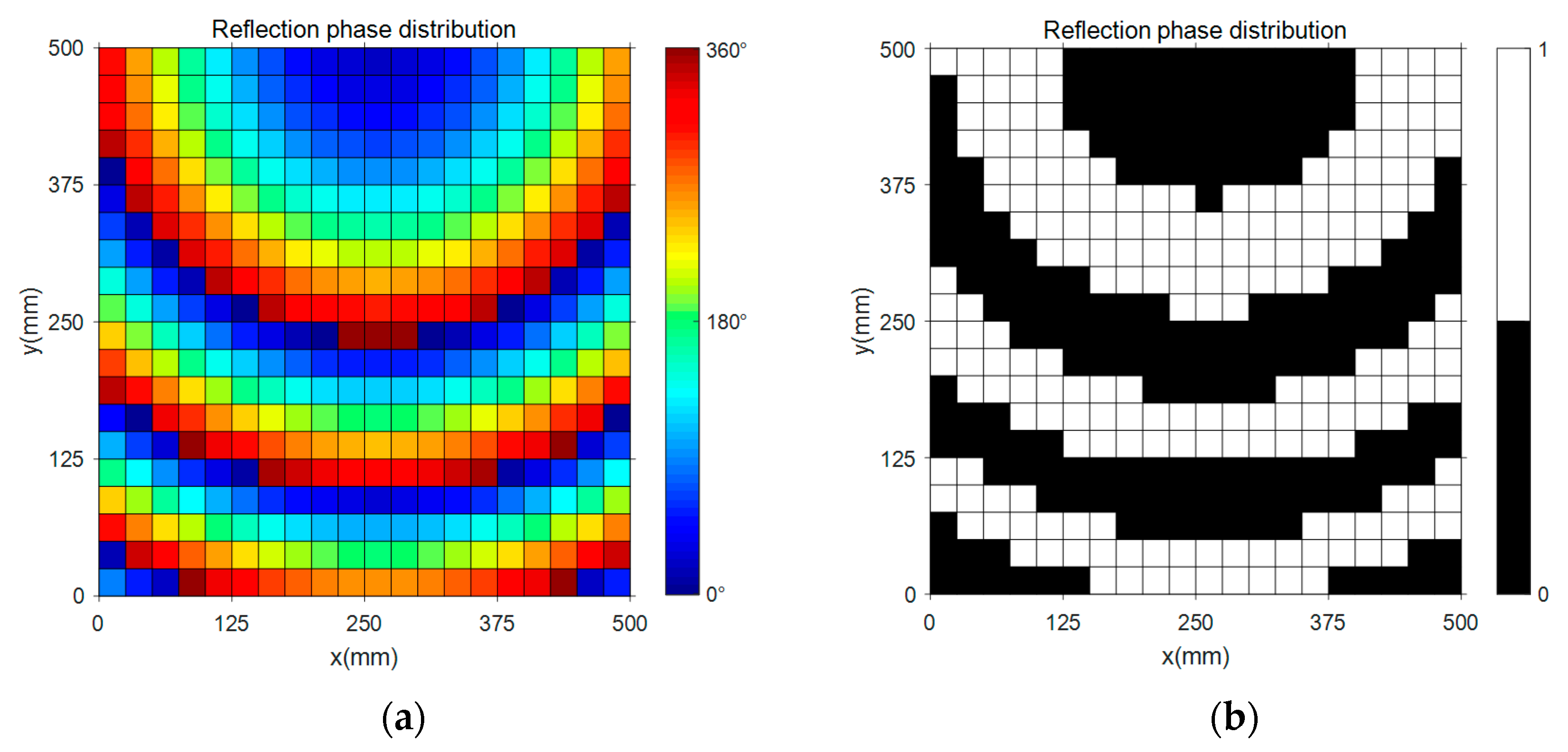
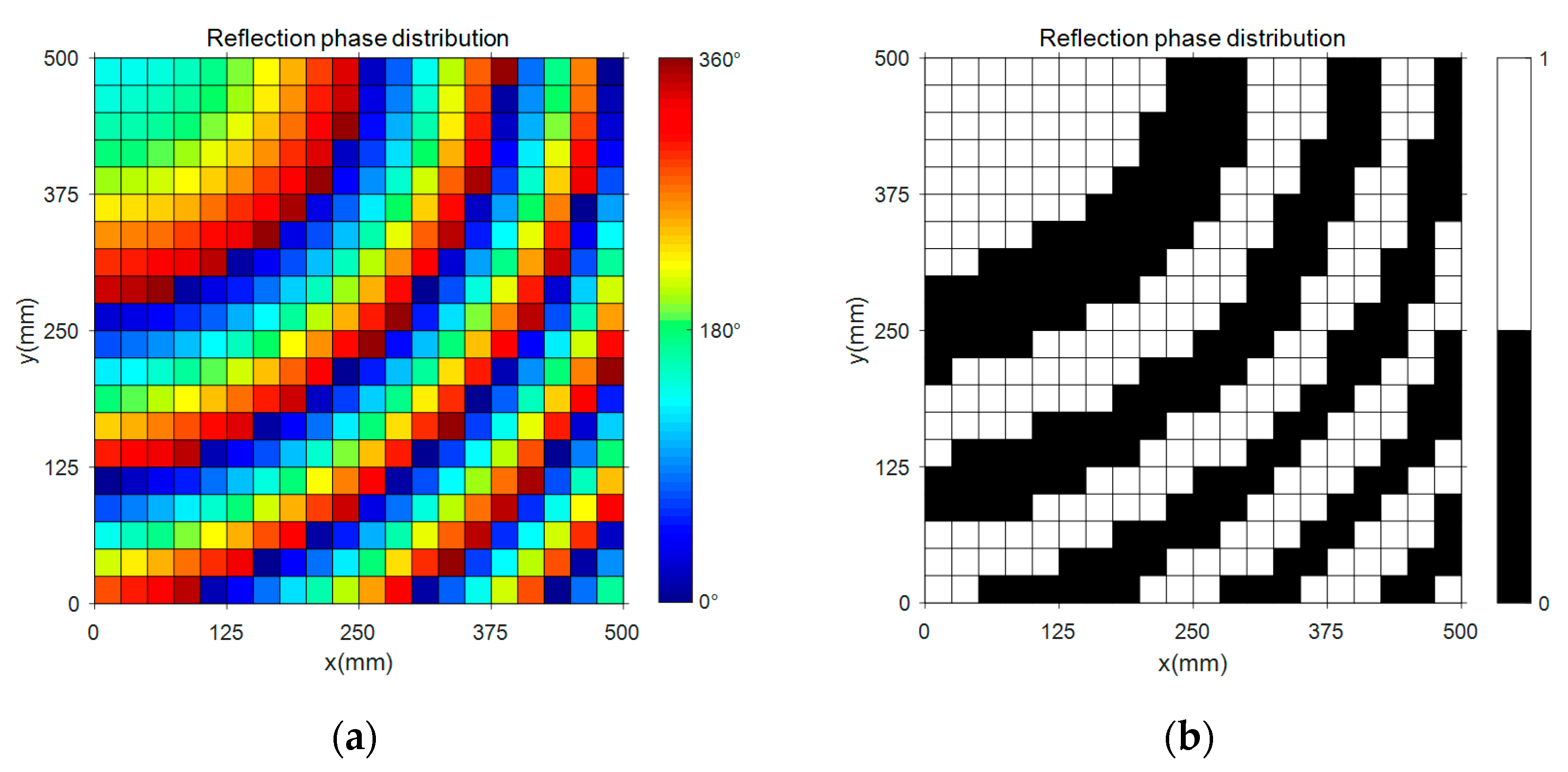
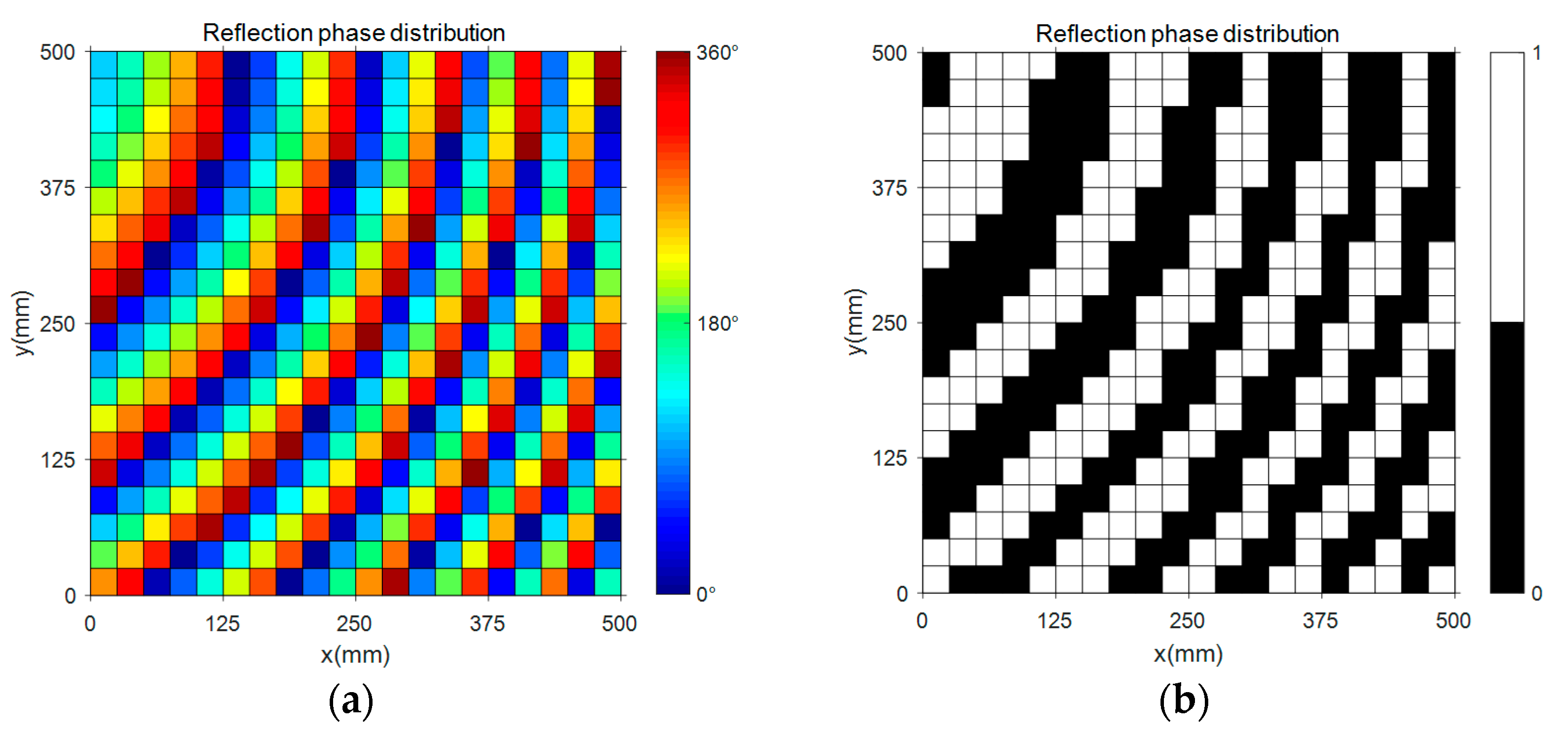
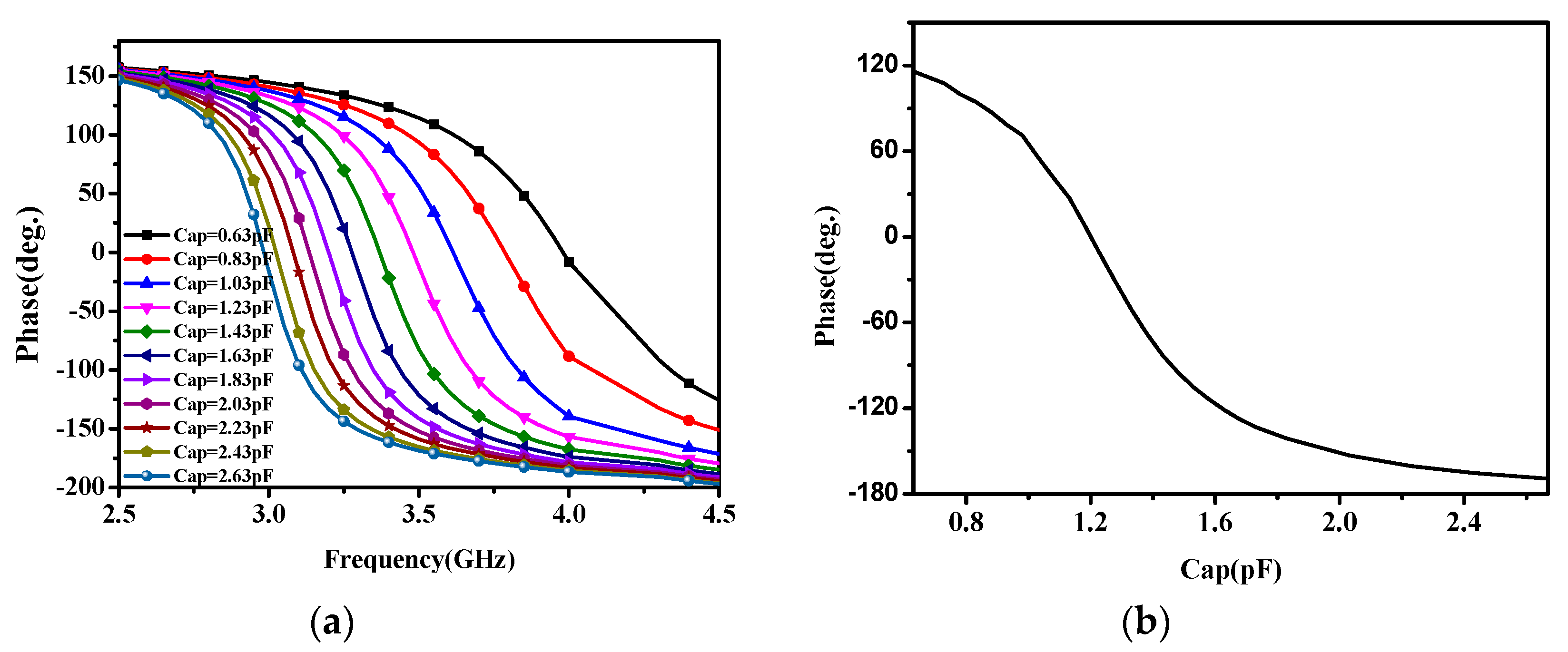

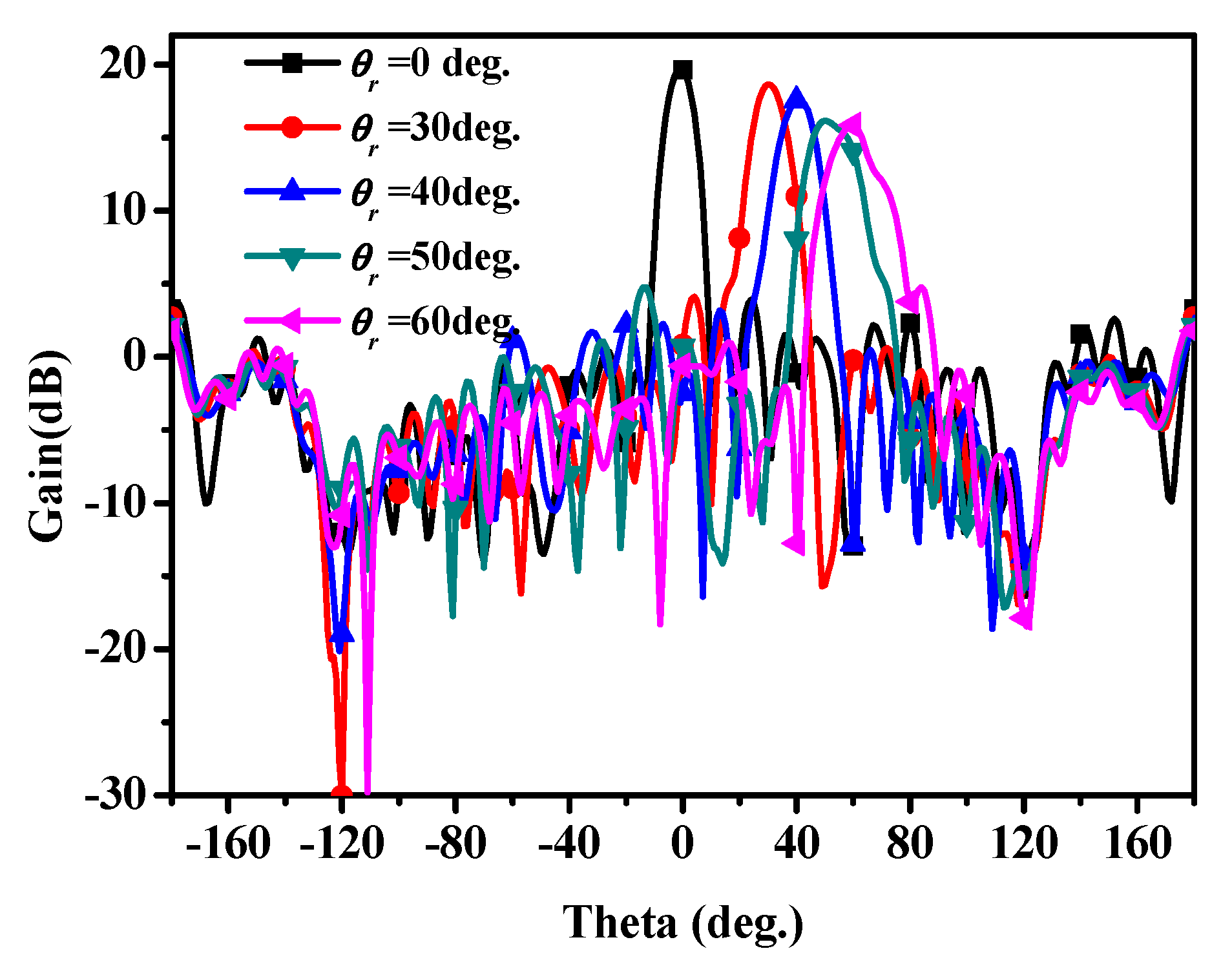

| Parameter | Value | Parameter | Value |
|---|---|---|---|
| L | 25 mm | Lx | 22.5 mm |
| Gap | 0.5 mm | Ly | 22.5 mm |
| Gain (dB) | Beam Point Error | Gain (dB) | Beam Point Error | ||
|---|---|---|---|---|---|
| 19.89 | 0° | 16.16 | 0° | ||
| 18.65 | 0° | 15.85 | 0° | ||
| 17.59 | 0° |
© 2017 by the authors. Licensee MDPI, Basel, Switzerland. This article is an open access article distributed under the terms and conditions of the Creative Commons Attribution (CC BY) license (http://creativecommons.org/licenses/by/4.0/).
Share and Cite
Tian, S.; Liu, H.; Li, L. Design of 1-Bit Digital Reconfigurable Reflective Metasurface for Beam-Scanning. Appl. Sci. 2017, 7, 882. https://doi.org/10.3390/app7090882
Tian S, Liu H, Li L. Design of 1-Bit Digital Reconfigurable Reflective Metasurface for Beam-Scanning. Applied Sciences. 2017; 7(9):882. https://doi.org/10.3390/app7090882
Chicago/Turabian StyleTian, Shuncheng, Haixia Liu, and Long Li. 2017. "Design of 1-Bit Digital Reconfigurable Reflective Metasurface for Beam-Scanning" Applied Sciences 7, no. 9: 882. https://doi.org/10.3390/app7090882






